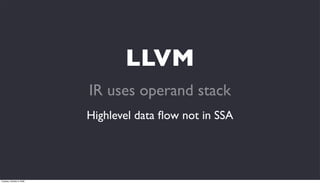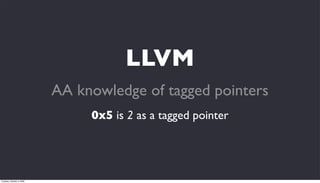Ad
Accelerating Ruby with LLVM
- 1. Accelerating Ruby with LLVM Evan Phoenix Oct 2, 2009 Tuesday, October 6, 2009
- 2. RUBY Tuesday, October 6, 2009
- 3. RUBY Strongly, dynamically typed Tuesday, October 6, 2009
- 4. RUBY Unified Model Tuesday, October 6, 2009
- 5. RUBY Everything is an object Tuesday, October 6, 2009
- 6. RUBY 3.class # => Fixnum Tuesday, October 6, 2009
- 7. RUBY Every code context is equal Tuesday, October 6, 2009
- 8. RUBY Every context is a method Tuesday, October 6, 2009
- 9. RUBY Garbage Collected Tuesday, October 6, 2009
- 10. RUBY A lot of syntax Tuesday, October 6, 2009
- 11. RUBY Strongly, dynamically typed Every code context is equal Unified model Every context is a method Everything is an object Garbage collected 3.class A lot of syntax Tuesday, October 6, 2009
- 12. Rubinius Tuesday, October 6, 2009
- 13. Rubinius Started in 2006 Tuesday, October 6, 2009
- 14. Rubinius Build a ruby environment for fun Tuesday, October 6, 2009
- 15. Rubinius Unlike most “scripting” languages, write as much in ruby as possible Tuesday, October 6, 2009
- 16. Rubinius Core functionality of perl/python/ruby in C, NOT in their respective language. Tuesday, October 6, 2009
- 17. Rubinius C => ruby => C => ruby Tuesday, October 6, 2009
- 18. Rubinius Language boundaries suck Tuesday, October 6, 2009
- 19. Rubinius Started in 2006 Built for fun Turtles all the way down Tuesday, October 6, 2009
- 20. Evolution Tuesday, October 6, 2009
- 21. Evolution 100% ruby prototype running on 1.8 Tuesday, October 6, 2009
- 22. Evolution Hand translated VM to C Tuesday, October 6, 2009
- 23. Evolution Rewrote VM in C++ Tuesday, October 6, 2009
- 24. Evolution Switch away from stackless Tuesday, October 6, 2009
- 25. Evolution Experimented with handwritten assembler for x86 Tuesday, October 6, 2009
- 26. Evolution Switch to LLVM for JIT Tuesday, October 6, 2009
- 27. Evolution 100% ruby prototype Switch away from stackless Hand translated VM to C Experiment with assembler Rewrote VM in C++ Switch to LLVM for JIT Tuesday, October 6, 2009
- 28. Features Tuesday, October 6, 2009
- 29. Features Bytecode VM Tuesday, October 6, 2009
- 30. Features Simple interface to native code Tuesday, October 6, 2009
- 31. Features Accurate, generational garbage collector Tuesday, October 6, 2009
- 32. Features Integrated FFI API Tuesday, October 6, 2009
- 33. Features Bytecode VM Generational GC Interface to native code Integrated FFI Tuesday, October 6, 2009
- 34. Benchmarks Tuesday, October 6, 2009
- 35. def foo() ary = [] 100.times { |i| ary << i } end 300,000 times Tuesday, October 6, 2009
- 36. Seconds 9 8.02 6.75 5.90 5.30 4.5 3.60 2.25 2.59 0 1.8 1.9 rbx rbx jit rbx jit +blocks Tuesday, October 6, 2009
- 37. def foo() hsh = {} 100.times { |i| hsh[i] = 0 } end 100,000 times Tuesday, October 6, 2009
- 38. Seconds 30 25.36 22.5 15 12.54 12.01 7.5 4.85 5.26 0 1.8 1.9 rbx rbx jit rbx jit +blocks Tuesday, October 6, 2009
- 39. def foo() hsh = { 47 => true } 100.times { |i| hsh[i] } end 100,000 times Tuesday, October 6, 2009
- 40. Seconds 7 6.26 5.25 3.5 3.64 2.68 2.66 2.09 1.75 0 1.8 1.9 rbx rbx jit rbx jit +blocks Tuesday, October 6, 2009
- 41. Early LLVM Usage Tuesday, October 6, 2009
- 42. Early LLVM Usage Compiled all methods up front Tuesday, October 6, 2009
- 43. Early LLVM Usage Simple opcode-to-function translation with inlining Tuesday, October 6, 2009
- 44. Early LLVM Usage Startup went from 0.3s to 80s Tuesday, October 6, 2009
- 45. Early LLVM Usage Compiled all methods upfront Simple opcode-to-function translation Startup from 0.3s to 80s Tuesday, October 6, 2009
- 46. True JIT Tuesday, October 6, 2009
- 47. True JIT JIT Goals Tuesday, October 6, 2009
- 48. True JIT JIT Goals Choose methods that benefit the most Tuesday, October 6, 2009
- 49. True JIT JIT Goals Compiling has minimum impact on performance Tuesday, October 6, 2009
- 50. True JIT JIT Goals Ability to make intelligent frontend decisions Tuesday, October 6, 2009
- 51. Choosing Methods Tuesday, October 6, 2009
- 52. Choosing Methods Simple call counters Tuesday, October 6, 2009
- 53. Choosing Methods When counter trips, the fun starts Tuesday, October 6, 2009
- 54. Choosing Methods Room for improvement Tuesday, October 6, 2009
- 55. Choosing Methods Room for improvement Increment counters in loops Tuesday, October 6, 2009
- 56. Choosing Methods Room for improvement Weigh different invocations differently Tuesday, October 6, 2009
- 57. Choosing Methods Simple counters Room for improvement Trip the counters, do it Increment in loops Weigh invocations Tuesday, October 6, 2009
- 58. Which Method? Tuesday, October 6, 2009
- 59. Which Method? Leaf methods trip quickly Tuesday, October 6, 2009
- 60. Which Methods? Leaf methods trip quickly Consider the whole callstack Tuesday, October 6, 2009
- 61. Which Methods? Leaf methods trip quickly Pick a parent expecting inlining Tuesday, October 6, 2009
- 62. Which Method? Leaf methods trip Consider the callstack Find a parent Tuesday, October 6, 2009
- 63. Minimal Impact Tuesday, October 6, 2009
- 64. Minimal Impact After the counters trip Tuesday, October 6, 2009
- 65. Minimal Impact Queue the method Tuesday, October 6, 2009
- 66. Minimal Impact Background thread drains queue Tuesday, October 6, 2009
- 67. Minimal Impact Frontend, passes, codegen in background Tuesday, October 6, 2009
- 68. Minimal Impact Install JIT’d function Tuesday, October 6, 2009
- 69. Minimal Impact Install JIT’d function Requires GC interaction Tuesday, October 6, 2009
- 70. Minimal Impact Trip the counters Compile in background Queue the method Install function pointer Tuesday, October 6, 2009
- 71. Good Decisions Tuesday, October 6, 2009
- 72. Good Decisions Naive translation yields fixed improvement Tuesday, October 6, 2009
- 73. Good Decisions Performance shifts to method dispatch Tuesday, October 6, 2009
- 74. Good Decisions Improve optimization horizon Tuesday, October 6, 2009
- 75. Good Decisions Inline using type feedback Tuesday, October 6, 2009
- 76. Good Decisions Naive translation sucks Performance in dispatch Inline using type feedback Improve optimizations Tuesday, October 6, 2009
- 77. Type Feedback Tuesday, October 6, 2009
- 78. Type Feedback Frontend translates to IR Tuesday, October 6, 2009
- 79. Type Feedback Read InlineCache information Tuesday, October 6, 2009
- 80. Type Feedback InlineCaches contain profiling info Tuesday, October 6, 2009
- 81. Type Feedback Use profiling to drive inlining! Tuesday, October 6, 2009
- 82. Type Feedback Frontend generates IR InlineCaches have profiling Reads InlineCaches Use profiling to drive inlining! Tuesday, October 6, 2009
- 83. Inlining Tuesday, October 6, 2009
- 84. Inlining Profiling info shows a dominant class Tuesday, October 6, 2009
- 85. 2 1% 1 class 98% Tuesday, October 6, 2009
- 86. Inlining Lookup method in compiler Tuesday, October 6, 2009
- 87. Inlining For native functions, emit direct call Tuesday, October 6, 2009
- 88. Inlining For FFI, inline conversions and call Tuesday, October 6, 2009
- 89. Inlining Find dominant class Emit direct calls if possible Lookup method Tuesday, October 6, 2009
- 90. Inlining Ruby Tuesday, October 6, 2009
- 91. Inlining Ruby Policy decides on inlining Tuesday, October 6, 2009
- 92. Inlining Ruby Drive sub-frontend at call site Tuesday, October 6, 2009
- 93. Inlining Ruby All inlining occurs in the frontend Tuesday, October 6, 2009
- 94. Inlining Ruby Generated IR preserves runtime data Tuesday, October 6, 2009
- 95. Inlining Ruby Generated IR preserves runtime data GC roots, backtraces, etc Tuesday, October 6, 2009
- 96. Inlining Ruby No AST between bytecode and IR Tuesday, October 6, 2009
- 97. Inlining Ruby No AST between bytecode and IR Fast, but limits the ability to generate better IR Tuesday, October 6, 2009
- 98. Inlining Ruby Policy decides Preserve runtime data Drive sub-frontend Generates fast, ugly IR Tuesday, October 6, 2009
- 99. LLVM Tuesday, October 6, 2009
- 100. LLVM IR uses operand stack Tuesday, October 6, 2009
- 101. LLVM IR uses operand stack Highlevel data flow not in SSA Tuesday, October 6, 2009
- 102. LLVM IR uses operand stack Passes eliminate redundencies Tuesday, October 6, 2009
- 103. LLVM IR uses operand stack Makes GC stack marking easy Tuesday, October 6, 2009
- 104. LLVM IR uses operand stack nocapture improves propagation Tuesday, October 6, 2009
- 105. LLVM Exceptions via sentinal value Tuesday, October 6, 2009
- 106. LLVM Exceptions via sentinal value Nested handlers use branches for control Tuesday, October 6, 2009
- 107. LLVM Exceptions via sentinal value Inlining exposes redundant checks Tuesday, October 6, 2009
- 108. LLVM Inline guards Tuesday, October 6, 2009
- 109. LLVM Inline guards Simple type guards Tuesday, October 6, 2009
- 110. if(obj->class->class_id == <integer constant>) { Tuesday, October 6, 2009
- 111. LLVM Inline guards Custom AA pass for guard elimination Tuesday, October 6, 2009
- 112. LLVM Inline guards Teach pointsToConstantMemory about... Tuesday, October 6, 2009
- 113. if(obj->class->class_id == <integer constant>) { Tuesday, October 6, 2009
- 114. if(obj->class->class_id == <integer constant>) { Tuesday, October 6, 2009
- 115. LLVM Maximizing constant propagation Tuesday, October 6, 2009
- 116. LLVM Maximizing constant propagation Type failures shouldn’t contribute values Tuesday, October 6, 2009
- 117. if(obj->class->class_id == 0x33) { val = 0x7; } else { val = send_msg(state, obj, ...); } Tuesday, October 6, 2009
- 118. if(obj->class->class_id == 0x33) { val = 0x7; } else { return uncommon(state); } Tuesday, October 6, 2009
- 119. LLVM Maximizing constant propagation Makes JIT similar to tracing Tuesday, October 6, 2009
- 120. LLVM Use overflow intrinsics Tuesday, October 6, 2009
- 121. LLVM Use overflow intrinsics Custom pass to fold constants arguments Tuesday, October 6, 2009
- 122. LLVM AA knowledge for tagged pointers Tuesday, October 6, 2009
- 123. LLVM AA knowledge of tagged pointers 0x5 is 2 as a tagged pointer Tuesday, October 6, 2009
- 124. LLVM Not in SSA form Maximize constants Simplistic exceptions Use overflow Inlining guards Tagged pointer AA Tuesday, October 6, 2009
- 125. Issues Tuesday, October 6, 2009
- 126. Issues How to link with LLVM? Tuesday, October 6, 2009
- 127. Issues How to link with LLVM? An important SCM issue Tuesday, October 6, 2009
- 128. Issues Ugly, confusing IR from frontend Tuesday, October 6, 2009
- 129. Issues instcombine confuses basicaa Tuesday, October 6, 2009
- 130. Issues Operand stack confuses AA Tuesday, October 6, 2009
- 131. Issues Inability to communicate semantics Tuesday, October 6, 2009
- 132. Object* new_object(state) Tuesday, October 6, 2009
- 133. Returned pointer aliases nothing Only modifies state If return value is unused, remove the call Semi-pure? Tuesday, October 6, 2009
- 134. Issues Ugly IR AA confusion Linking with LLVM Highlevel semantics Tuesday, October 6, 2009
- 135. Thanks! http://rubini.us [email protected] Tuesday, October 6, 2009


































![def foo()
ary = []
100.times { |i| ary << i }
end
300,000 times
Tuesday, October 6, 2009](https://image.slidesharecdn.com/llvmdevmeeting2-091006203334-phpapp01/85/Accelerating-Ruby-with-LLVM-35-320.jpg)

![def foo()
hsh = {}
100.times { |i| hsh[i] = 0 }
end
100,000 times
Tuesday, October 6, 2009](https://image.slidesharecdn.com/llvmdevmeeting2-091006203334-phpapp01/85/Accelerating-Ruby-with-LLVM-37-320.jpg)

![def foo()
hsh = { 47 => true }
100.times { |i| hsh[i] }
end
100,000 times
Tuesday, October 6, 2009](https://image.slidesharecdn.com/llvmdevmeeting2-091006203334-phpapp01/85/Accelerating-Ruby-with-LLVM-39-320.jpg)



















































































































































